Agent-Based Simulation and Micro Supply Chain of the Food–Energy–Water Nexus for Collaborating Urban Farms and the Incorporation of a Community Microgrid Based on Renewable Energy
Abstract
1. Introduction
2. Literature Review
3. Methods and Procedures
3.1. Agent-Based Model
3.1.1. Farmer Agent
3.1.2. Household Agent
3.1.3. Microgrid Agent
3.1.4. Electricity Grid Agent
3.1.5. Water Agent
3.2. Optimization Model
4. Experimental/Numerical Setting
5. Results and Discussion
5.1. Social Sustainability
5.2. Economic Sustainability
5.3. Environmental Sustainability
5.4. Micro Supply Chain Results
5.5. Implication of the Results and Discussion
6. Conclusions and Future Research
Author Contributions
Funding
Data Availability Statement
Conflicts of Interest
References
- Simpson, G.B.; Jewitt, G.P.W. The Development of the Water-Energy-Food Nexus as a Framework for Achieving Resource Security: A Review. Front. Environ. Sci. 2019, 7, 8. [Google Scholar] [CrossRef]
- Alexandratos, N.; Bruinsma, J. World Agriculture towards 2030/2050: The 2012 Revision; FAO: Rome, Italy, 2012; ISSN 2521-1838. [Google Scholar]
- McKenzie, F.C.; Williams, J. Sustainable food production: Constraints, challenges and choices by 2050. Food Secur. 2015, 7, 221–233. [Google Scholar] [CrossRef]
- Bajželj, B.; Richards, K.S.; Allwood, J.M.; Smith, P.; Dennis, J.S.; Curmi, E.; Gilligan, C.A. Importance of food-demand management for climate mitigation. Nat. Clim. Chang. 2014, 4, 924–929. [Google Scholar] [CrossRef]
- Boretti, A.; Rosa, L. Reassessing the projections of the World Water Development Report. Npj Clean Water 2019, 2, 15. [Google Scholar] [CrossRef]
- Kaufman, J.; Bailkey, M. Farming inside Cities: Entrepreneurial Urban Agriculture in the United States; Lincoln Institute of Land Policy: Cambridge, MA, USA, 2001. [Google Scholar]
- Weber, C.L.; Matthews, H.S. Food-Miles and the Relative Climate Impacts of Food Choices in the United States. Environ. Sci. Technol. 2008, 42, 3508–3513. [Google Scholar] [CrossRef]
- Elkamel, M.; Valencia, A.; Zhang, W.; Zheng, Q.P.; Chang, N.-B. Multi-agent modeling for linking a green transportation system with an urban agriculture network in a food-energy-water nexus. Sustain. Cities Soc. 2023, 89, 104354. [Google Scholar] [CrossRef]
- Abar, S.; Theodoropoulos, G.K.; Lemarinier, P.; O’Hare, G.M.P. Agent Based Modelling and Simulation tools: A review of the state-of-art software. Comput. Sci. Rev. 2017, 24, 13–33. [Google Scholar] [CrossRef]
- Widener, M.J.; Metcalf, S.S.; Bar-Yam, Y. Agent-based modeling of policies to improve urban food access for low-income populations. Appl. Geogr. 2013, 40, 1–10. [Google Scholar] [CrossRef]
- Dobbie, S.; Schreckenberg, K.; Dyke, J.G.; Schaafsma, M.; Balbi, S. Agent-Based Modelling to Assess Community Food Security and Sustainable Livelihoods. J. Artif. Soc. Soc. Simul. 2018, 21, 9. [Google Scholar] [CrossRef]
- Ghandar, A.; Theodoropoulos, G.; Zhong, M.; Zhen, B.; Chen, S.; Gong, Y.; Ahmed, A. An Agent-Based Modelling Framework for Urban Agriculture. In Proceedings of the 2019 Winter Simulation Conference (WSC), National Harbor, MD, USA, 8–11 December 2019; pp. 1767–1778. [Google Scholar]
- Giulioni, G. An Agent-Based Modeling and Simulation Approach to Commodity Markets. Soc. Sci. Comput. Rev. 2018, 37, 355–370. [Google Scholar] [CrossRef]
- Calisti, R.; Proietti, P.; Marchini, A. Promoting Sustainable Food Consumption: An Agent-Based Model About Outcomes of Small Shop Openings. J. Artif. Soc. Soc. Simul. 2019, 22, 2. [Google Scholar] [CrossRef]
- Marvuglia, A.; Bayram, A.; Baustert, P.; Gutiérrez, T.N.; Igos, E. Agent-based modelling to simulate farmers’ sustainable decisions: Farmers’ interaction and resulting green consciousness evolution. J. Clean. Prod. 2022, 332, 129847. [Google Scholar] [CrossRef]
- Ng, T.L.; Eheart, J.W.; Cai, X.; Braden, J.B. An agent-based model of farmer decision-making and water quality impacts at the watershed scale under markets for carbon allowances and a second-generation biofuel crop. Water Resour. Res. 2011, 47. [Google Scholar] [CrossRef]
- Lopez-Jimenez, J.; Quijano, N.; Wouwer, A.V. On the Use of Agent-Based Modeling for Smart Farming. In Proceedings of the 2018 22nd International Conference on System Theory, Control and Computing (ICSTCC), Sinaia, Romania, 10–12 October 2018; pp. 348–353. [Google Scholar]
- Feng, K.; Hubacek, K.; Siu, Y.L.; Li, X. The energy and water nexus in Chinese electricity production: A hybrid life cycle analysis. Renew. Sustain. Energy Rev. 2014, 39, 342–355. [Google Scholar] [CrossRef]
- Chen, S.; Chen, B. Urban energy consumption: Different insights from energy flow analysis, input–output analysis and ecological network analysis. Appl. Energy 2015, 138, 99–107. [Google Scholar] [CrossRef]
- Zaman, K.; Khan, M.M.; Ahmad, M.; Rustam, R. The relationship between agricultural technology and energy demand in Pakistan. Energy Policy 2012, 44, 268–279. [Google Scholar] [CrossRef]
- Alimagham, S.M.; Soltani, A.; Zeinali, E.; Kazemi, H. Energy flow analysis and estimation of greenhouse gases (GHG) emissions in different scenarios of soybean production (Case study: Gorgan region, Iran). J. Clean. Prod. 2017, 149, 621–628. [Google Scholar] [CrossRef]
- Babel, M.S.; Shrestha, B.; Perret, S.R. Hydrological impact of biofuel production: A case study of the Khlong Phlo Watershed in Thailand. Agric. Water Manag. 2011, 101, 8–26. [Google Scholar] [CrossRef]
- Mortensen, J.G.; González-Pinzón, R.; Dahm, C.N.; Wang, J.; Zeglin, L.H.; Van Horn, D.J. Advancing the Food-Energy–Water Nexus: Closing Nutrient Loops in Arid River Corridors. Environ. Sci. Technol. 2016, 50, 8485–8496. [Google Scholar] [CrossRef] [PubMed]
- Flörke, M.; Schneider, C.; McDonald, R.I. Water competition between cities and agriculture driven by climate change and urban growth. Nat. Sustain. 2018, 1, 51–58. [Google Scholar] [CrossRef]
- Nie, Y.; Avraamidou, S.; Xiao, X.; Pistikopoulos, E.N.; Li, J.; Zeng, Y.; Song, F.; Yu, J.; Zhu, M. A Food-Energy-Water Nexus approach for land use optimization. Sci. Total Environ. 2019, 659, 7–19. [Google Scholar] [CrossRef] [PubMed]
- Khan, H.F.; Yang, Y.C.E.; Xie, H.; Ringler, C. A coupled modeling framework for sustainable watershed management in transboundary river basins. Hydrol. Earth Syst. Sci. 2017, 21, 6275–6288. [Google Scholar] [CrossRef]
- Newell, B.; Marsh, D.; Sharma, D. Enhancing the Resilience of the Australian National Electricity Market: Taking a Systems Approach in Policy Development. Ecol. Soc. 2011, 16, 15. [Google Scholar] [CrossRef]
- Markantonis, V.; Reynaud, A.; Karabulut, A.; El Hajj, R.; Altinbilek, D.; Awad, I.M.; Bruggeman, A.; Constantianos, V.; Mysiak, J.; Lamaddalena, N.; et al. Can the Implementation of the Water-Energy-Food Nexus Support Economic Growth in the Mediterranean Region? The Current Status and the Way Forward. Front. Environ. Sci. 2019, 7, 84. [Google Scholar] [CrossRef]
- Abatekassa, G.; Peterson, C. Market Access for Local Food through the Conventional Food Supply Chain. Int. Food Agribus. Manag. Rev. 2011, 14, 63–82. [Google Scholar]
- Alam, M.M. Mango supply chain and value chain analysis from farm to market. Int. J. Supply Chain Manag. 2018, 7, 7–12. [Google Scholar]
- Marsden, T.; Banks, J.; Bristow, G. Food Supply Chain Approaches: Exploring their Role in Rural Development. Sociol. Rural. 2000, 40, 424–438. [Google Scholar] [CrossRef]
- Utomo, D.S.; Onggo, B.S.S.; Eldridge, S.; Daud, A.R.; Tejaningsih, S. Eliciting agents’ behaviour using scenario-based questionnaire in agent-based dairy supply chain simulation. J. Simul. 2022, 16, 58–72. [Google Scholar] [CrossRef]
- Krejci, C.; Beamon, B.M. Assessing regional farm-to-institution food distribution systems: An agent-based approach. IIE Annu. Conf. Expo 2014, 2014, 3592–3601. [Google Scholar]
- Khanh, H.N.; Chiong, R.; Chica, M.; Middleton, R.H. Agent-based simulation of contract rice farming in the Mekong Delta, Vietnam. In Proceedings of the 2017 21st Asia Pacific Symposium on Intelligent and Evolutionary Systems (IES), Hanoi, Vietnam, 15–17 November 2017; pp. 127–132. [Google Scholar]
- Mittal, A.; Gibson, N.O.; Krejci, C.C. An Agent-based Model of Surplus Food Rescue Using Crowd-shipping. In Proceedings of the 2019 Winter Simulation Conference (WSC), National Harbor, MD, USA, 8–11 December 2019; pp. 854–865. [Google Scholar]
- Krejci, C.; Beamon, B. Impacts of Farmer Coordination Decisions on Food Supply Chain Structure. J. Artif. Soc. Soc. Simul. 2015, 18, 19. [Google Scholar] [CrossRef]
- Utomo, D.S.; Onggo, B.S.; Eldridge, S. Applications of agent-based modelling and simulation in the agri-food supply chains. Eur. J. Oper. Res. 2018, 269, 794–805. [Google Scholar] [CrossRef]
- Remondino, M.; Zanin, A. Logistics and Agri-Food: Digitization to Increase Competitive Advantage and Sustainability. Literature Review and the Case of Italy. Sustainability 2022, 14, 787. [Google Scholar] [CrossRef]
- Day-Farnsworth, L.; Miller, M. Networking Across the Supply Chain: Transportation Innovations in Local and Regional Food Systems. Available online: https://ageconsearch.umn.edu/record/316237 (accessed on 1 December 2022).
- Paciarotti, C.; Torregiani, F. Short food supply chain between micro/small farms and restaurants. Br. Food J. 2018, 120, 1722–1734. [Google Scholar] [CrossRef]
- Sitaker, M.; Kolodinsky, J.; Jilcott Pitts, S.B.; Seguin, R.A. Do entrepreneurial food systems innovations impact rural economies and health? Evidence and gaps. Am. J. Entrep. 2014, 7, 3–16. [Google Scholar] [PubMed]
- Floriš, N.; Schwarcz, P.; Schwarczová, L.; Munk, M. Short Food Supply Chains and Small Farms—Evidence from Slovakia. Sustainability 2022, 14, 2728. [Google Scholar] [CrossRef]
- Dharmalingam, B.; Giri Nandagopal, M.S.; Thulasiraman, V.; Kothakota, A.; Rajkumar. Chapter Two—Short food supply chains to resolve food scarcity during COVID-19 pandemic—An Indian model. In Advances in Food Security and Sustainability; Cohen, M.J., Ed.; Elsevier: Amsterdam, The Netherlands, 2021; Volume 6, pp. 35–63. [Google Scholar]
- Sodiq, A.; Baloch, A.A.B.; Khan, S.A.; Sezer, N.; Mahmoud, S.; Jama, M.; Abdelaal, A. Towards modern sustainable cities: Review of sustainability principles and trends. J. Clean. Prod. 2019, 227, 972–1001. [Google Scholar] [CrossRef]
- Tavares, J.; Hoops, G.P.; Olshansky, H.P.; Rosen, R. Copenhagen’s Case for Urban Farming: A Feasibility Study; Worcester Polytechnic Institute: Worcester, MA, USA, 2018; Available online: https://digital.wpi.edu/show/fb4948799 (accessed on 1 December 2022).
- Akita, N. How Urban Agriculture Can Contribute to Green Infrastructure in Japanese Cities. In Urban Services to Ecosystems: Green Infrastructure Benefits from the Landscape to the Urban Scale; Catalano, C., Andreucci, M.B., Guarino, R., Bretzel, F., Leone, M., Pasta, S., Eds.; Springer International Publishing: Cham, Switzerland, 2021; pp. 227–242. [Google Scholar] [CrossRef]
- Chandra, A.J.; Diehl, J.A. Urban agriculture, food security, and development policies in Jakarta: A case study of farming communities at Kalideres—Cengkareng district, West Jakarta. Land Use Policy 2019, 89, 104211. [Google Scholar] [CrossRef]
- Likitswat, F. Urban Farming: Opportunities and Challenges of Developing Greenhouse Business in Bangkok Metropolitan Region. Future Cities Environ. 2021, 7, 8. [Google Scholar] [CrossRef]
- Rigillo, M.; Vigo Majello, M.C. Opportunities for Urban Farming in Cities. The Case Study of San Martino Hill in Naples, Italy. WIT Trans. Ecol. Environ. 2014, 191, 1671–1683. [Google Scholar]
- Bruce, D.D.; Ahmed, K.A. Urban Agriculture Case Studies in Central Texas: From the Ground to the Rooftop. In Urban Agriculture; Mohamed, S., Ed.; IntechOpen: Rijeka, Croatia, 2016; Chapter 2. [Google Scholar] [CrossRef]
- Althaus Ottman, M.M.; Maantay, J.A.; Grady, K.; Cardoso, N.; da Fonte, N.N. Community Gardens: An Exploration of Urban Agriculture in the Bronx, New York City. Cities Env. 2010, 3, 20. [Google Scholar]
- Schutzbank, M.; Riseman, A. Entrepreneurial Urban farms: An Urban farming census of Vancouver, British Columbia. Int. J. Environ. Sustain. 2013, 8, 131–163. [Google Scholar] [CrossRef]
- Mendes, W.; Balmer, K.; Kaethler, T.; Rhoads, A. Using Land Inventories to Plan for Urban Agriculture: Experiences From Portland and Vancouver. J. Am. Plan. Assoc. 2008, 74, 435–449. [Google Scholar] [CrossRef]
- City of Vancouver. Urban Farm Guidelines. Available online: https://guidelines.vancouver.ca/guidelines-urban-farm.pdf (accessed on 1 November 2022).
- City of Vancouver. Urban farming: Growing Food to Sell. Available online: https://vancouver.ca/people-programs/growing-food-for-sale.aspx (accessed on 1 November 2022).
- VUFS. Vancouver Urban Farming Society. Available online: http://urbanfarmers.ca/ (accessed on 1 November 2022).
- CleanBC. Roadmap to 2030. Available online: https://www2.gov.bc.ca/assets/gov/environment/climate-change/action/cleanbc/cleanbc_roadmap_2030.pdf (accessed on 1 November 2022).
- CleanBC. Is Rising to the Challenge of Climate Change. Available online: https://cleanbc.gov.bc.ca/ (accessed on 1 November 2022).
- Government of Canada. Historical Data: Past Weather and Climate. Available online: https://climate.weather.gc.ca/historical_data/search_historic_data_e.html (accessed on 1 November 2022).
- Vancouver Urban Farming Society. Urban Farming Census 2017–2019. Available online: http://urbanfarmers.ca/urban-farms/urban-farming-census/ (accessed on 1 November 2022).
- Selda, O.; Ustun, S.; Melek, E.; Metin, T.; Ertan, Y. Principles of Irrigation Management for Vegetables. In Vegetable Crops; Ertan, Y., Melek, E., Eds.; IntechOpen: Rijeka, Croatia, 2021; Chapter 13. [Google Scholar] [CrossRef]
- Statistics Canada. Statistics Canada: Canada’s National Statistical Agency. Available online: https://www.statcan.gc.ca/en/start (accessed on 1 November 2022).
- BC Hydro. Hydrometeorologic Data. Available online: https://www.bchydro.com/energy-in-bc/operations/transmission-reservoir-data/hydrometeorologic-data.html (accessed on 1 November 2022).
- Pfenninger, S.; Staffell, I. Long-term patterns of European PV output using 30 years of validated hourly reanalysis and satellite data. Energy 2016, 114, 1251–1265. [Google Scholar] [CrossRef]
- Staffell, I.; Pfenninger, S. Using bias-corrected reanalysis to simulate current and future wind power output. Energy 2016, 114, 1224–1239. [Google Scholar] [CrossRef]
- Jones, A.D.; Ngure, F.M.; Pelto, G.; Young, S.L. What Are We Assessing When We Measure Food Security? A Compendium and Review of Current Metrics. Adv. Nutr. 2013, 4, 481–505. [Google Scholar] [CrossRef]
- Smith, L.C.; Subandoro, A. Measuring Food Security Using Household Expenditure Surveys; International Food Policy Research Institute: Washington, DC, USA, 2007; Volume 3. [Google Scholar]

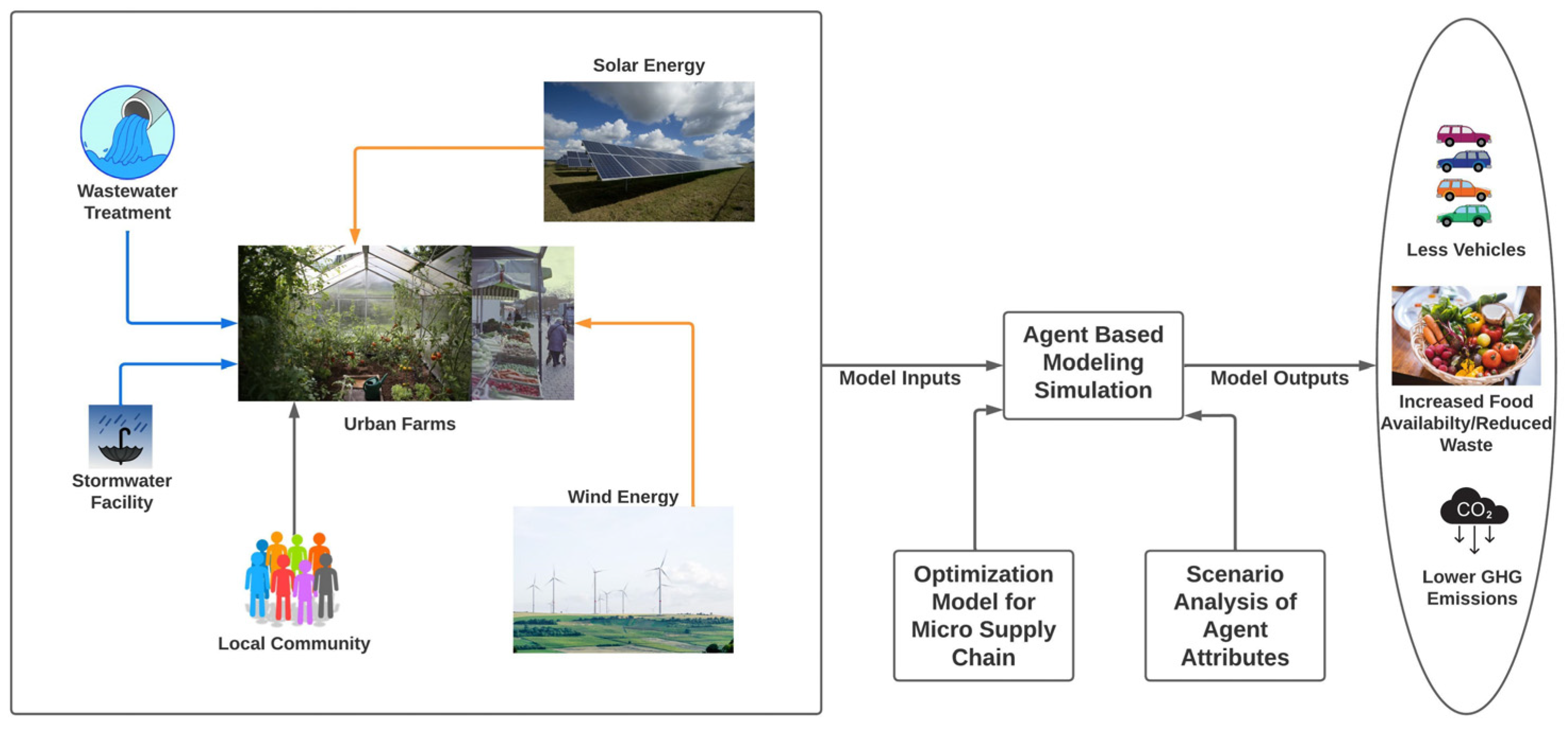
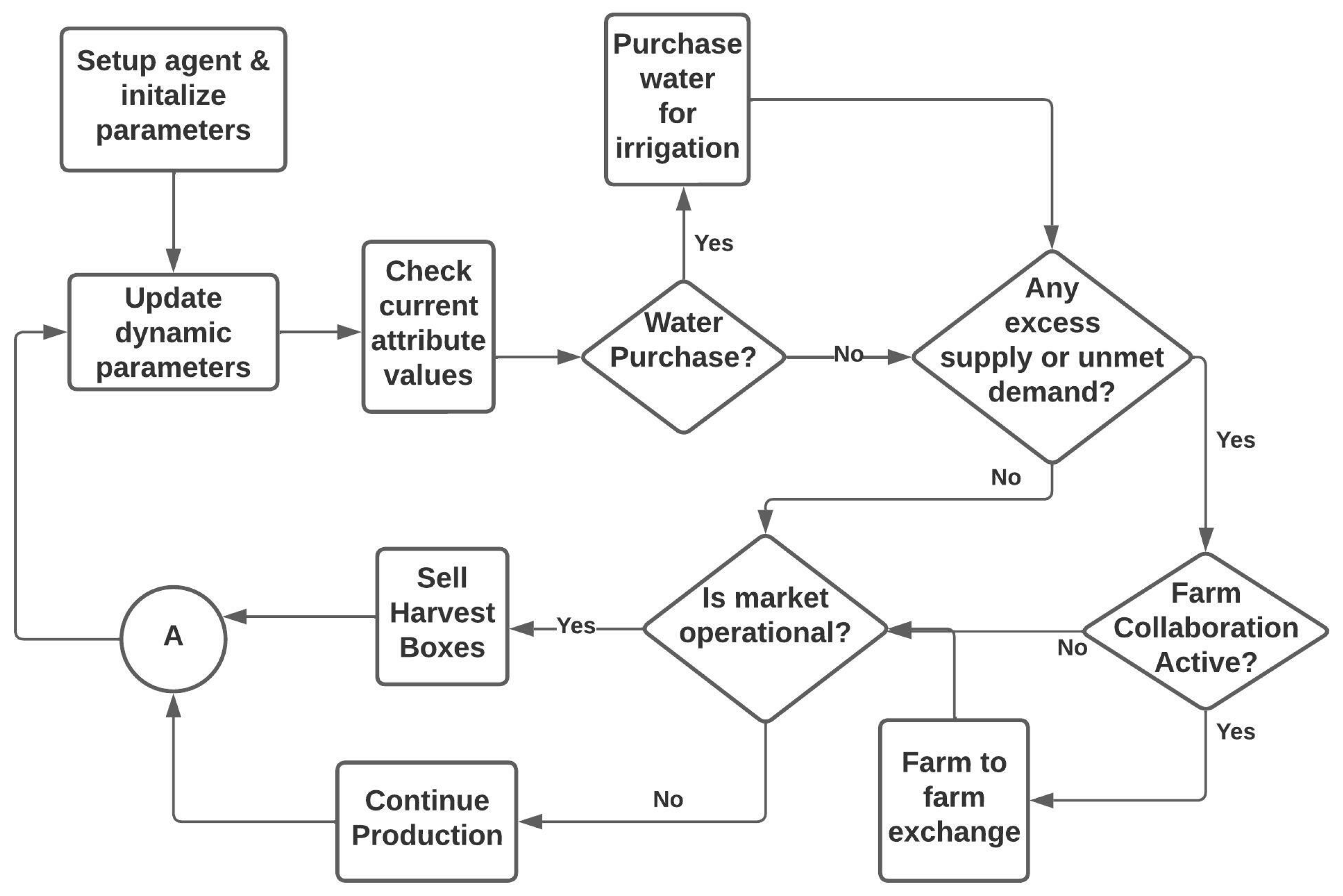
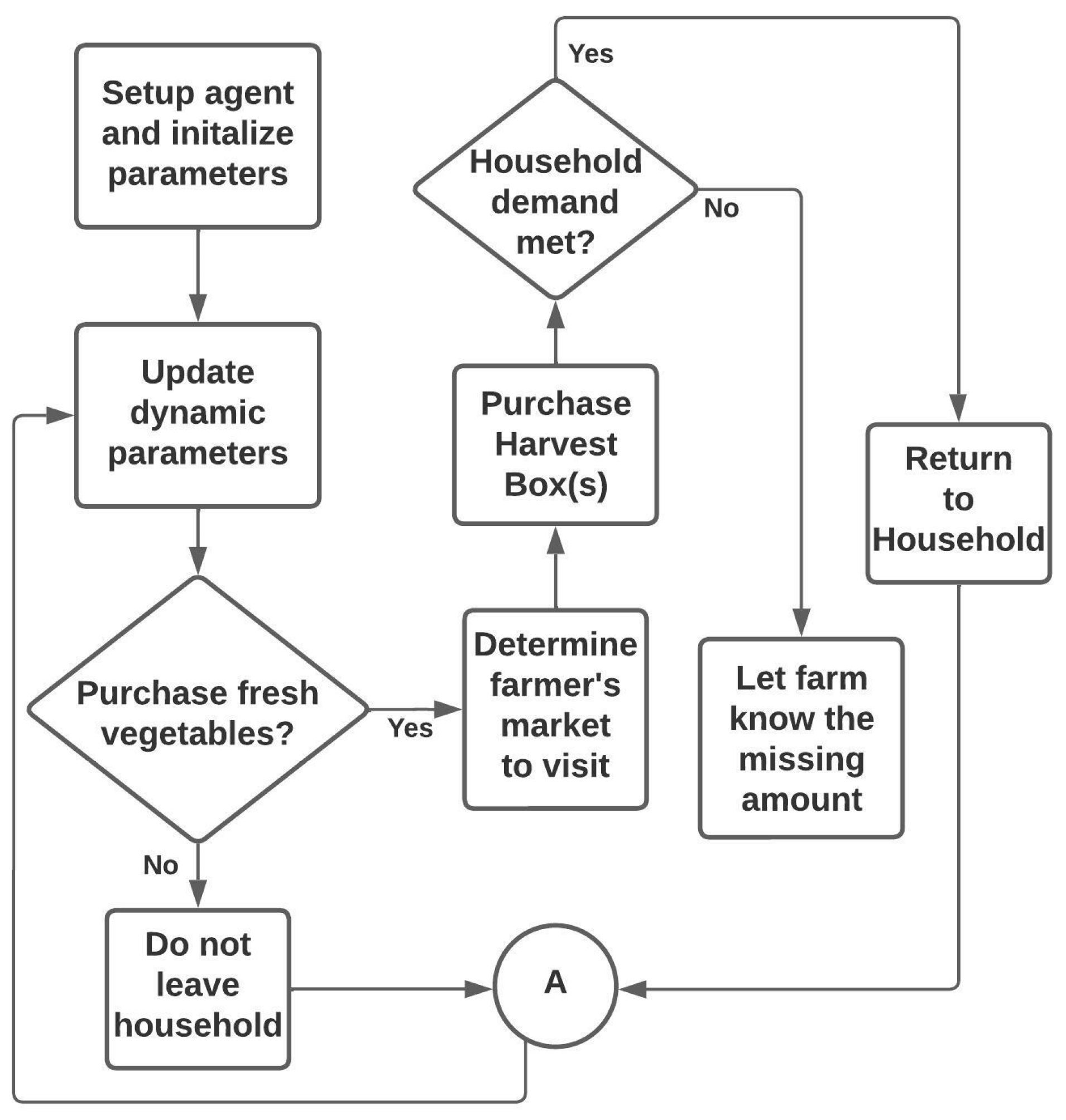
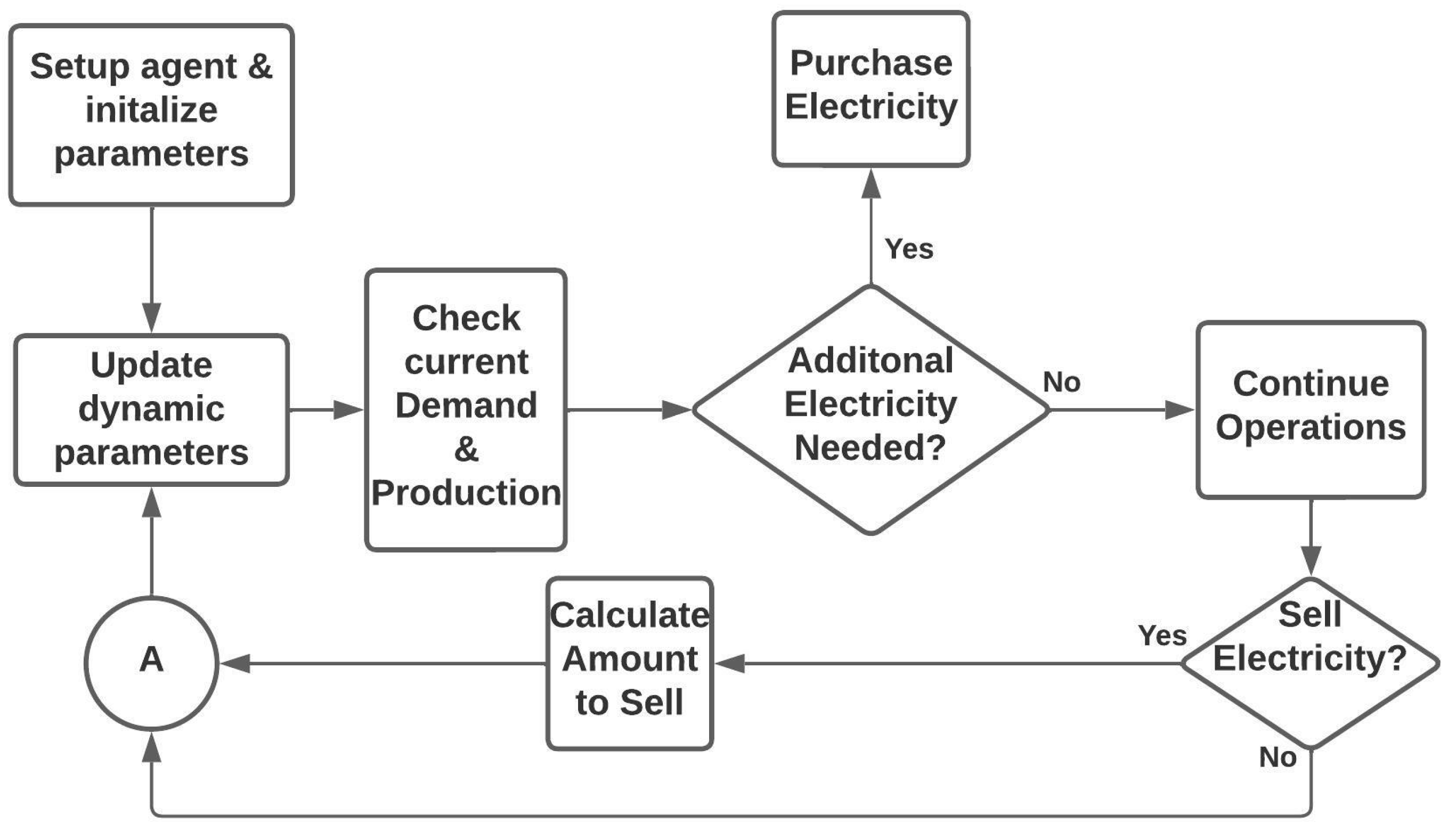
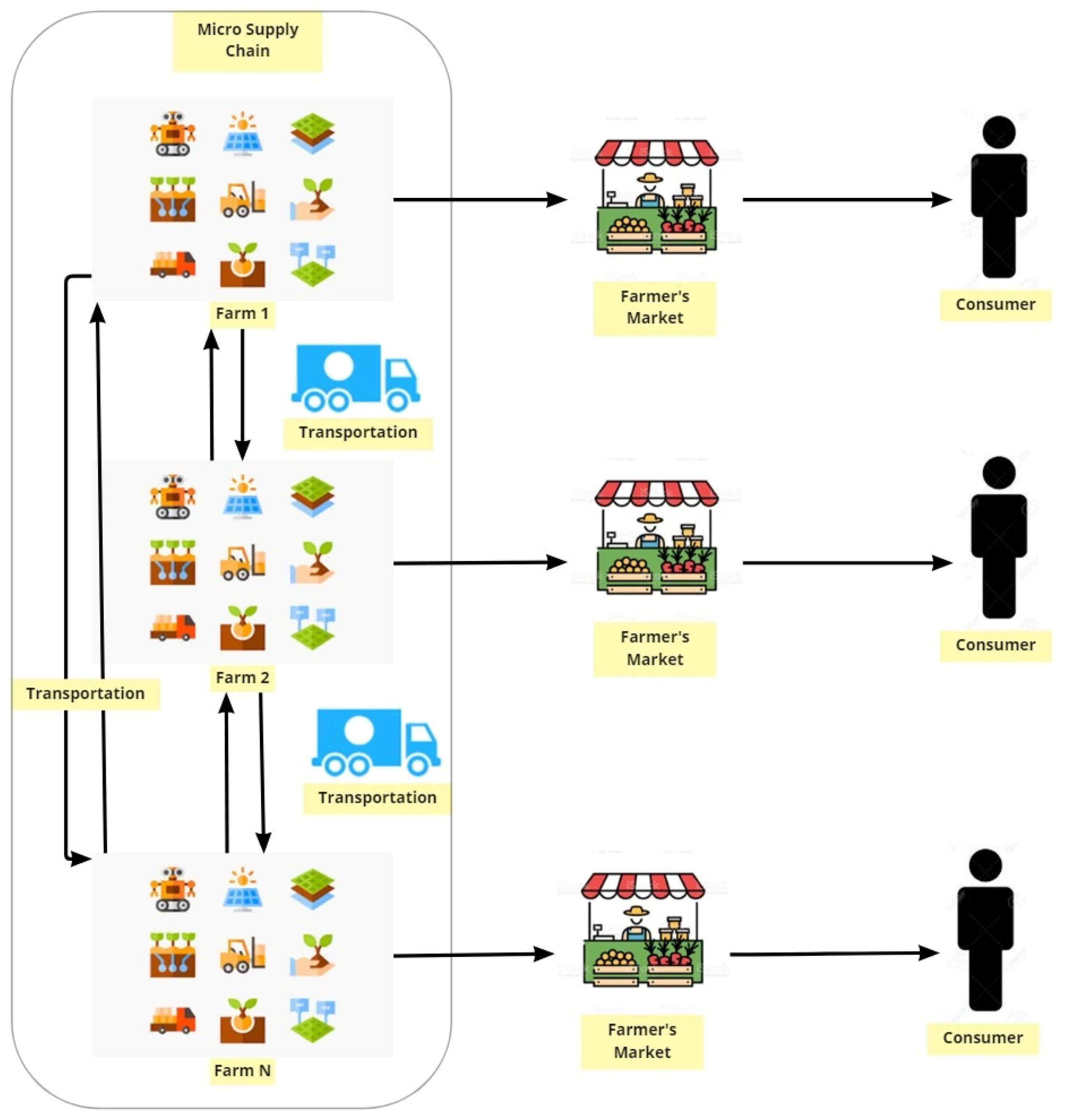
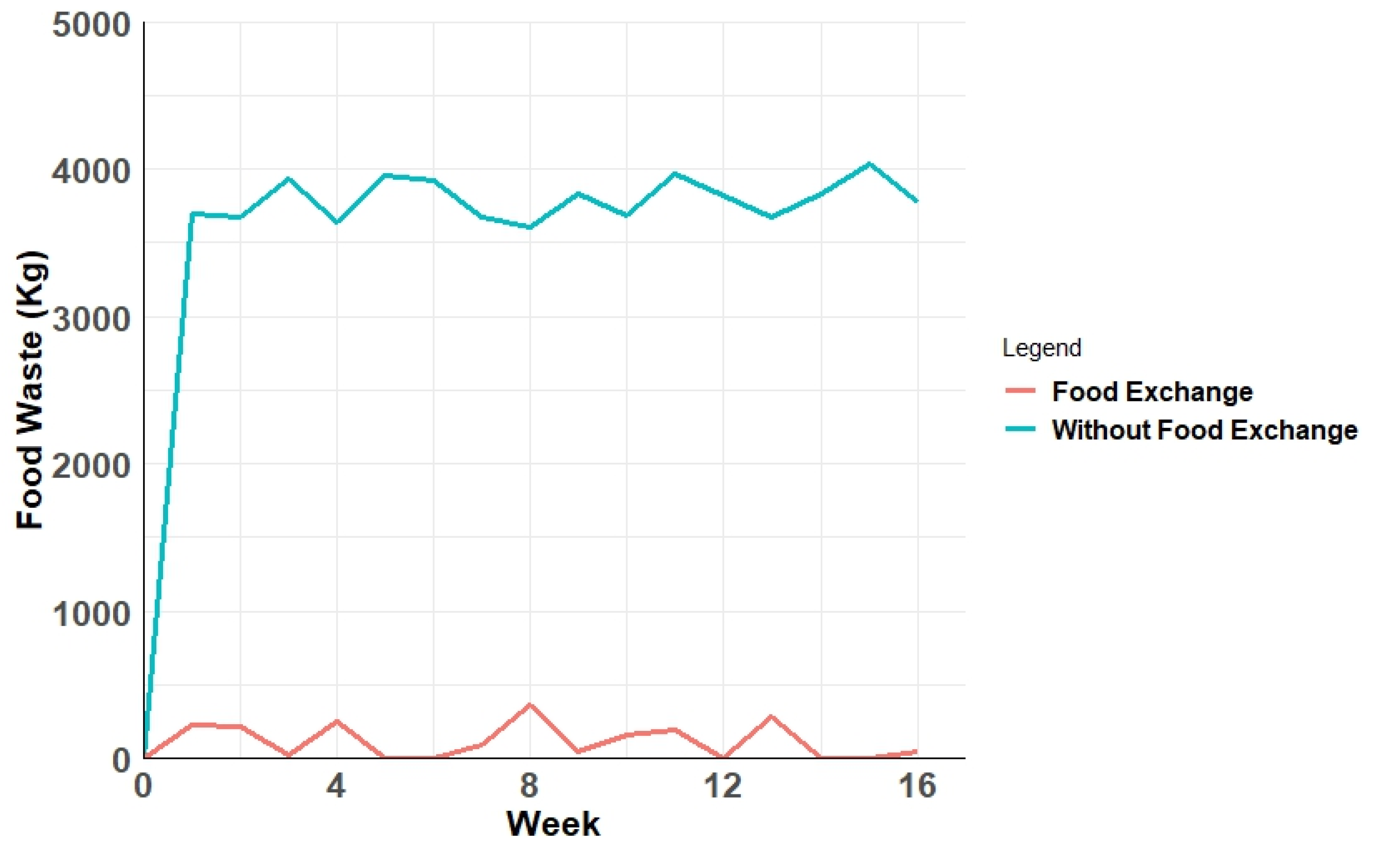
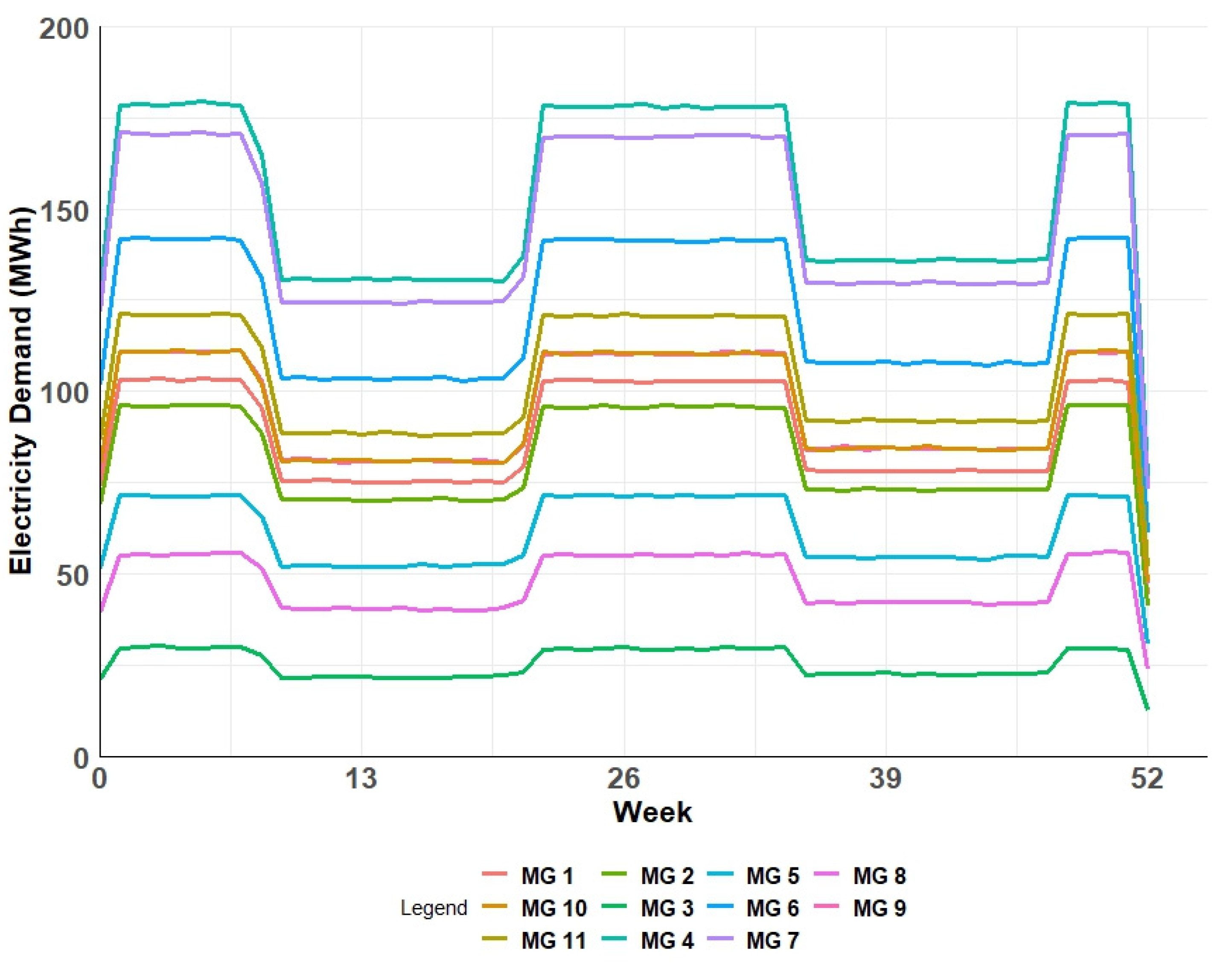
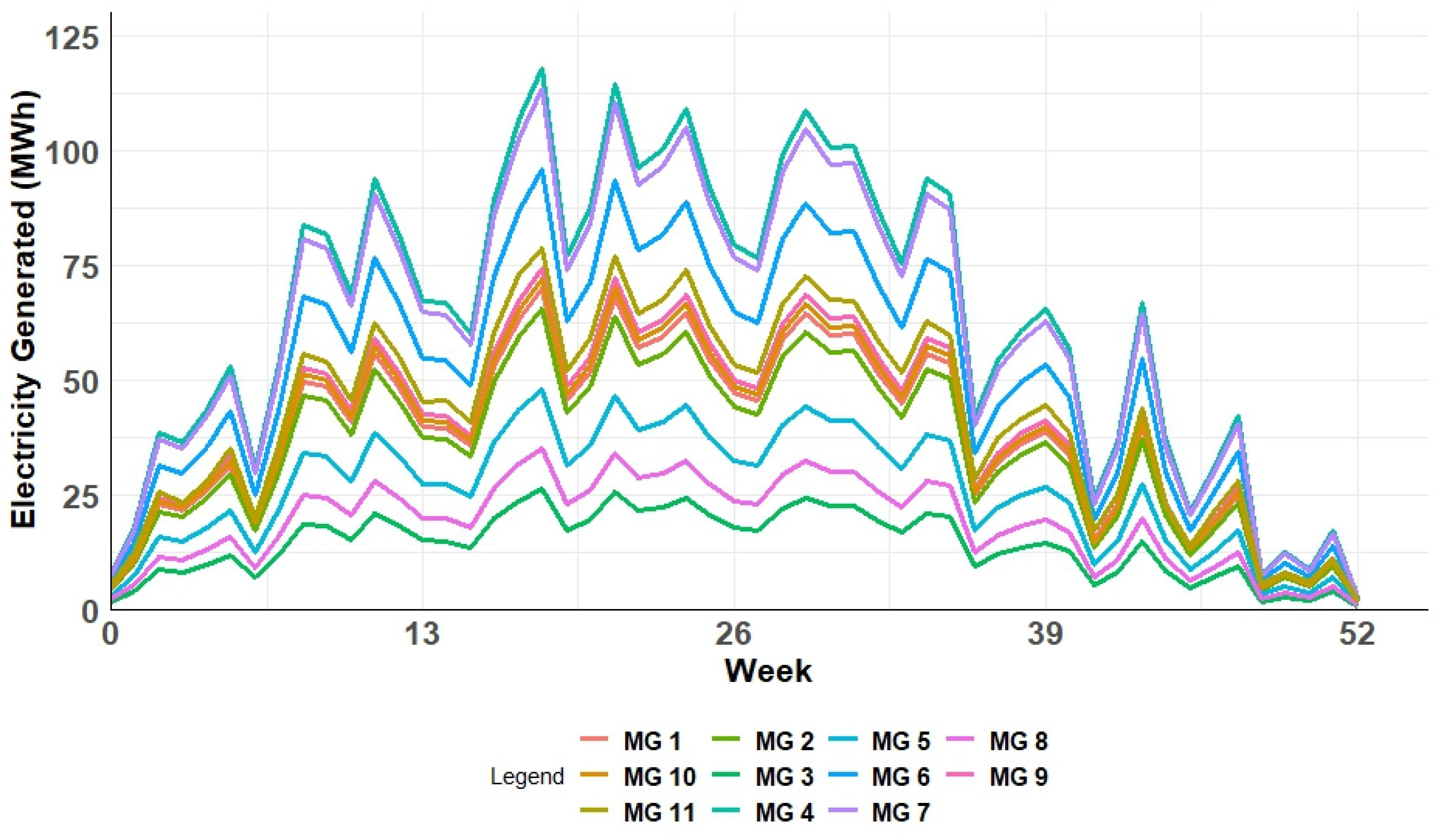
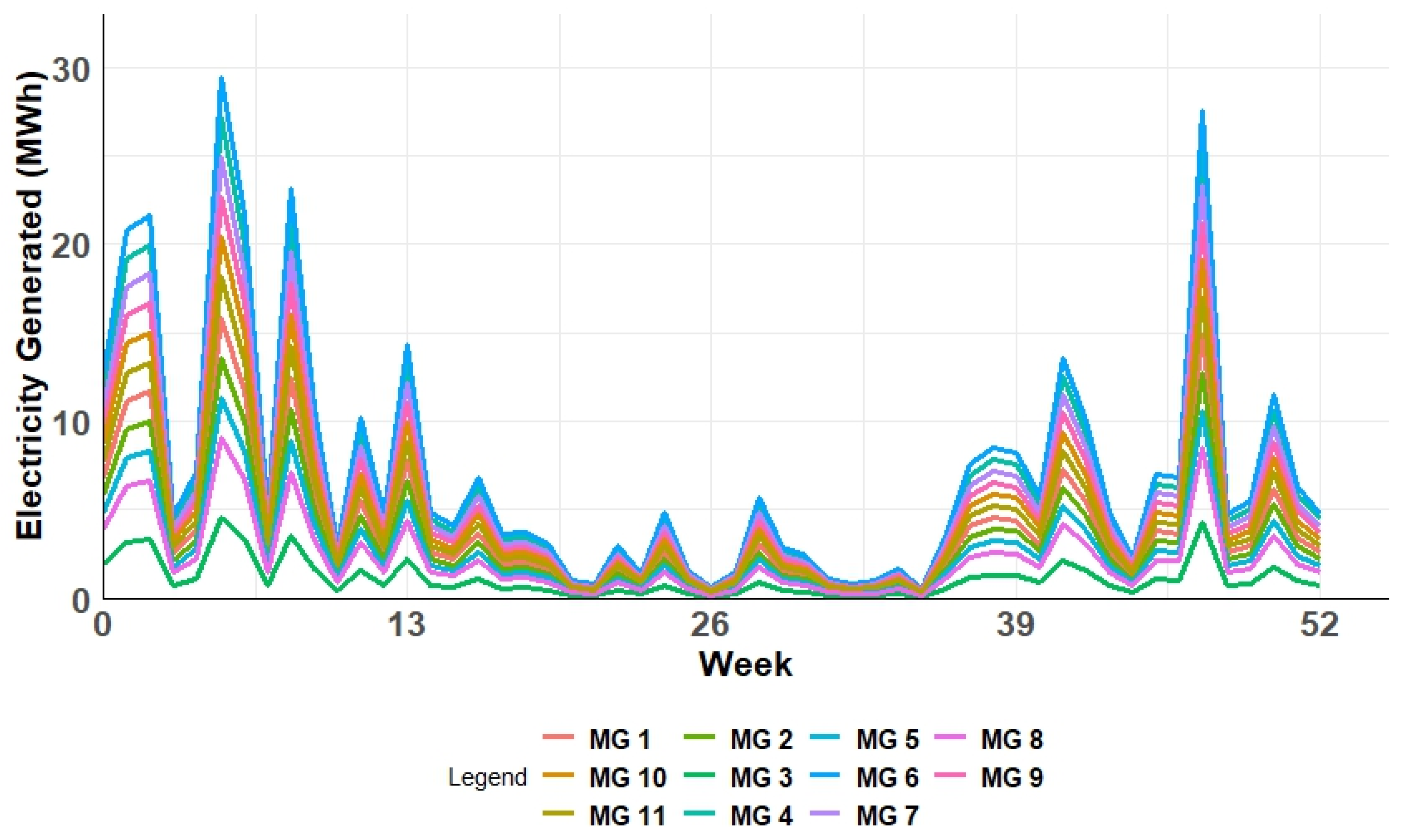


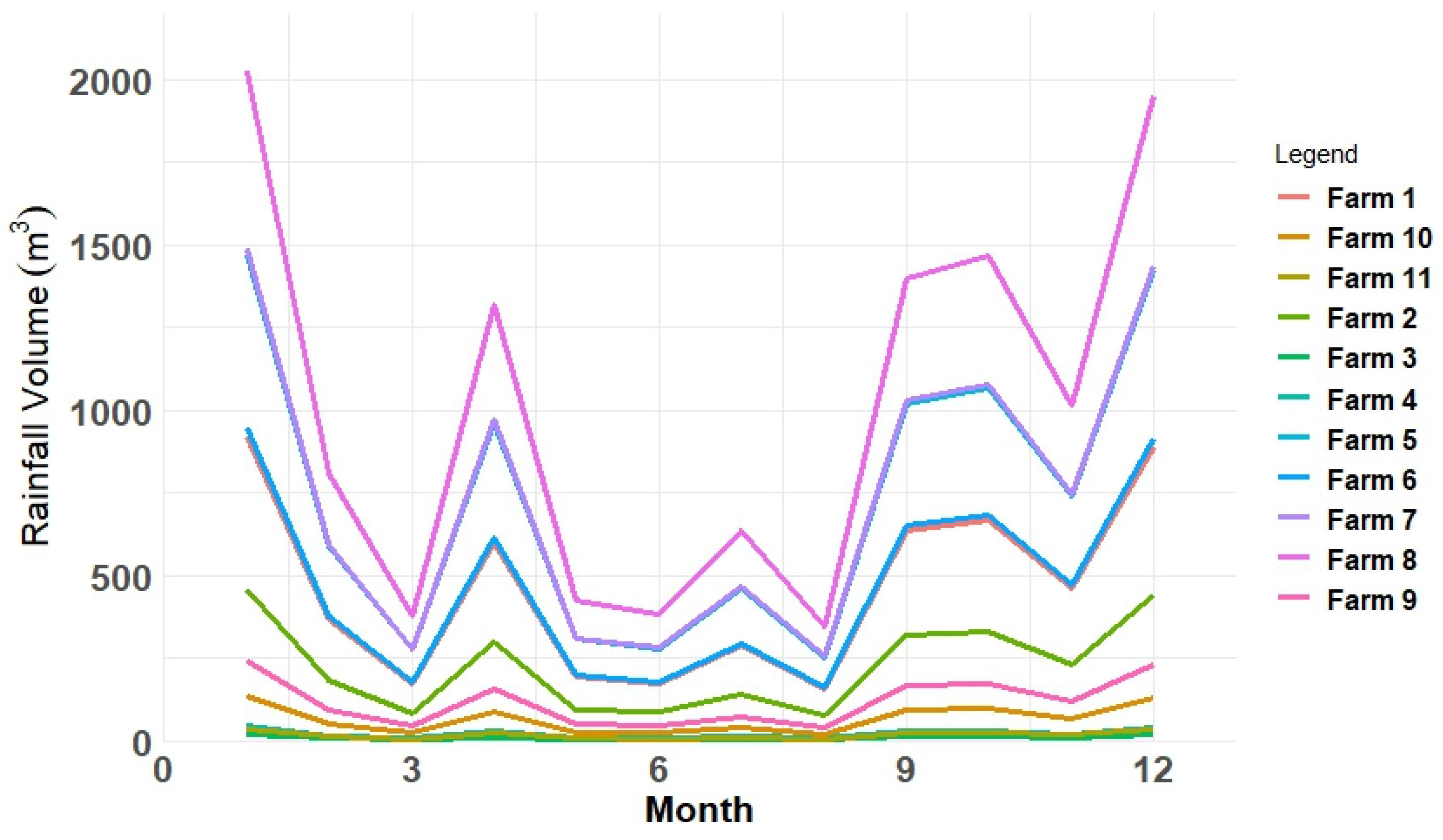

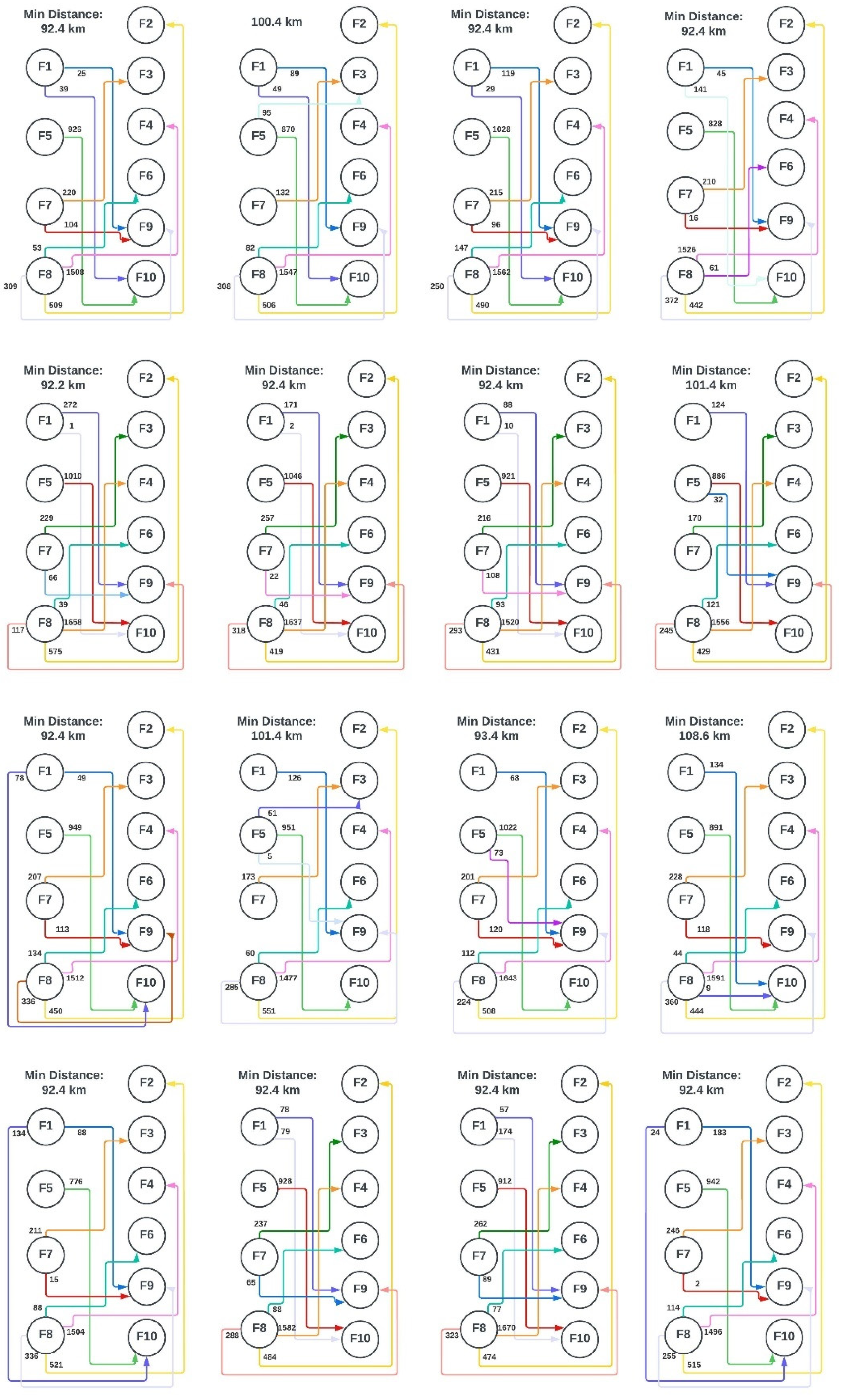
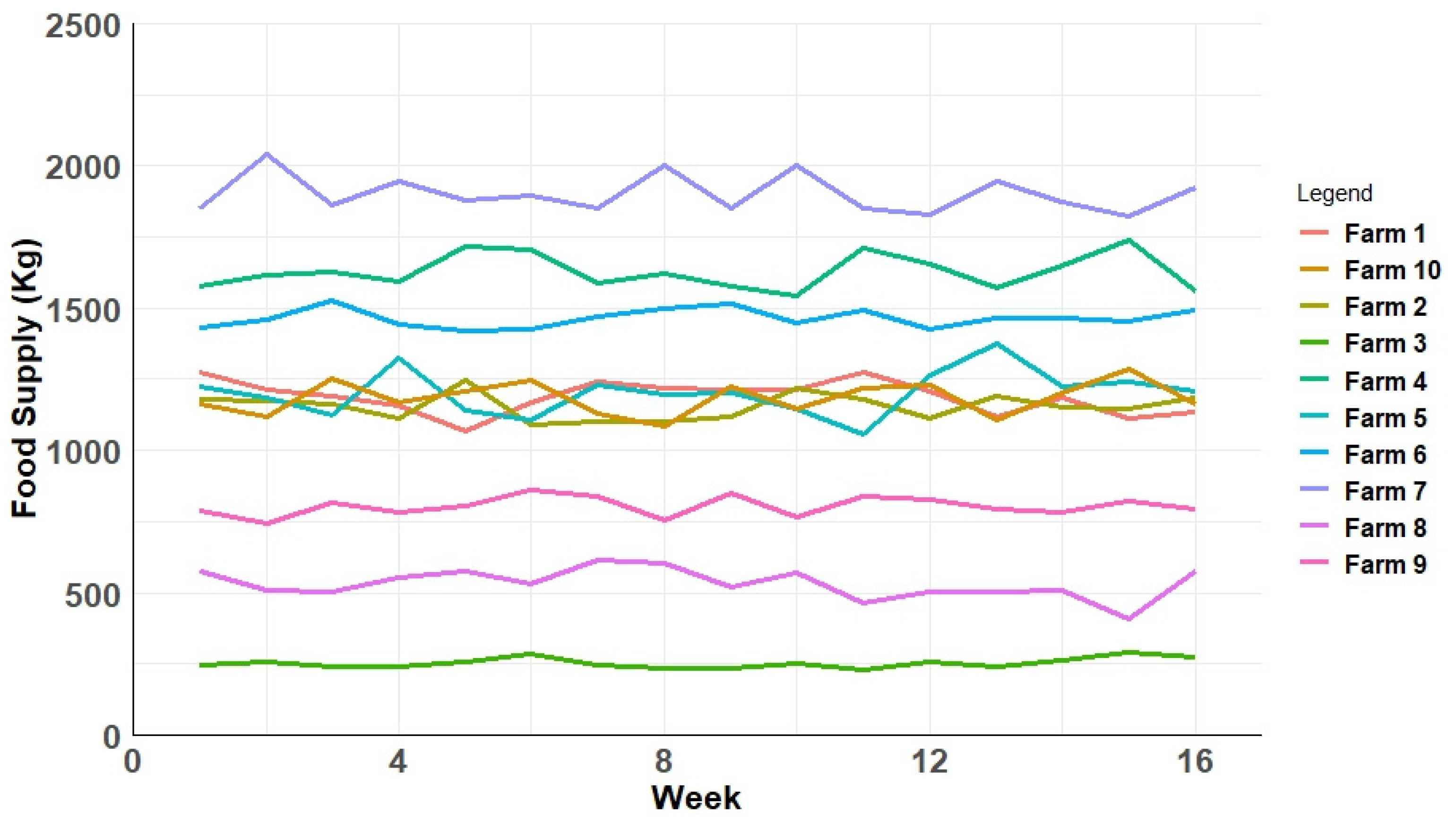
| Variables and Parameters | |
|---|---|
| The number of units shipped from the farm source, i, to the farm destination, j | |
| The cost of shipping one unit from the farm source i, to the farm destination, j | |
| The surplus (supply) at the farm source, i | |
| The deficit (demand) at the farm destination, j | |
| Objective Function | |
| Transportation Cost = | |
| Constraints: | |
| Case | Equation(s) |
|---|---|
| I | |
| II |
|
| III | |
| Farm # | Size (m2) | Production per Week (Kg) |
|---|---|---|
| 1 | 4047 | 1341 |
| 2 | 2023 | 670 |
| 3 | 86 | 28 |
| 4 | 201 | 66 |
| 5 | 6495 | 2152 |
| 6 | 4162 | 1379 |
| 7 | 6556 | 2172 |
| 8 | 8909 | 2953 |
| 9 | 1060 | 352 |
| 10 | 593 | 197 |
| 11 | 170 | 57 |
| MG | Avg Kwh Demand/h | Solar Capacity (Kwh) | Wind Capacity (Kwh) | Battery Capacity (Kwh) |
|---|---|---|---|---|
| 1 | 535 | 1600 | 350 | 320 |
| 2 | 499 | 1500 | 300 | 300 |
| 3 | 154 | 600 | 100 | 90 |
| 4 | 927 | 2700 | 600 | 550 |
| 5 | 371 | 1100 | 250 | 220 |
| 6 | 736 | 2200 | 650 | 440 |
| 7 | 884 | 2600 | 550 | 530 |
| 8 | 287 | 800 | 200 | 160 |
| 9 | 575 | 1700 | 500 | 330 |
| 10 | 575 | 1650 | 450 | 300 |
| 11 | 628 | 1800 | 400 | 350 |
Disclaimer/Publisher’s Note: The statements, opinions and data contained in all publications are solely those of the individual author(s) and contributor(s) and not of MDPI and/or the editor(s). MDPI and/or the editor(s) disclaim responsibility for any injury to people or property resulting from any ideas, methods, instructions or products referred to in the content. |
© 2023 by the authors. Licensee MDPI, Basel, Switzerland. This article is an open access article distributed under the terms and conditions of the Creative Commons Attribution (CC BY) license (https://creativecommons.org/licenses/by/4.0/).
Share and Cite
Elkamel, M.; Rabelo, L.; Sarmiento, A.T. Agent-Based Simulation and Micro Supply Chain of the Food–Energy–Water Nexus for Collaborating Urban Farms and the Incorporation of a Community Microgrid Based on Renewable Energy. Energies 2023, 16, 2614. https://doi.org/10.3390/en16062614
Elkamel M, Rabelo L, Sarmiento AT. Agent-Based Simulation and Micro Supply Chain of the Food–Energy–Water Nexus for Collaborating Urban Farms and the Incorporation of a Community Microgrid Based on Renewable Energy. Energies. 2023; 16(6):2614. https://doi.org/10.3390/en16062614
Chicago/Turabian StyleElkamel, Marwen, Luis Rabelo, and Alfonso T. Sarmiento. 2023. "Agent-Based Simulation and Micro Supply Chain of the Food–Energy–Water Nexus for Collaborating Urban Farms and the Incorporation of a Community Microgrid Based on Renewable Energy" Energies 16, no. 6: 2614. https://doi.org/10.3390/en16062614
APA StyleElkamel, M., Rabelo, L., & Sarmiento, A. T. (2023). Agent-Based Simulation and Micro Supply Chain of the Food–Energy–Water Nexus for Collaborating Urban Farms and the Incorporation of a Community Microgrid Based on Renewable Energy. Energies, 16(6), 2614. https://doi.org/10.3390/en16062614







